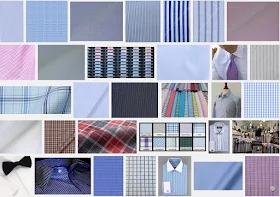Dress shirt fabrics come in various constructions such as
oxford, herringbone, twill, poplin, end-on-end, pinpoint, basket weave, ginham,
etc. Most of which are woven
fabrics. Shirt fabrics are also referenced as "shirtings".
Cotton is by
far the most common fabric for dress shirts, and most fabric names refer to a
particular method of weaving the shirting fabric. The numbers sometimes listed
with fabrics denote the thickness of the yarn from which the fabric is made;
higher numbers mean thinner yarn. The finer yarn results in a finer clothing
and typically higher prices.
Yarn is the generic term for a thin, long, continuous
strand of textile fiber before it is woven into cloth.
A yarn number tells you the diameter of the yarn used
in the fabric. Fabric has a lower yarn number because the yarn used to make the
shirt is wider. Thinner fabric has a higher number. Typically 80-100 signifies
high quality. Thread count is often referred to with a number like 50s, 80s,
100s, 120s, 140s 160s, etc. up to 200s.
Ply is a term used to describe the number of yarns
that are spun together in the shirt fabric. Two ply means that two different
yarns are twisted together before the shirting fabric is woven. Fabrics can
either be two-ply or single ply.
You might see a fabric’s construction described as something
like “100/2×100/2″. The way to read this is that it has 100s two-ply threads
running in both the warp and weft directions. Warp threads run vertically. Weft
yarns run horizontally.
Broadcloth—very similar to poplin–is a tightly woven
fabric with a very simple over-under weave and slight sheen, which makes it very
dressy. Broadcloths are great for guys looking for as little texture as
possible in their fabrics. They are generally a thinner, lighter
fabric.
Oxford vs. Pinpoint - The difference between the
fabrics is not in the weave, but in the thickness and weight of the yarns that
are used. Pinpoint generally has a higher thread count, and a lighter, finer
weave then Oxford Cloth. Thus, pinpoint dress shirts are preferable over oxford
cloth dress shirts in formal situations.
The construction of the cloth and yarn count is only part of
the shirt fabric puzzle. The fabric also must complete a proper finishing
process to be prepared for being cut and sewn into dress shirts. There are a
variety of processes that must occur before the cloth is considered “finished.”
These processes are referred to as the “finishing.” This process can include
dying, sizing, pre-shrinking, and sanforization (Sanforization is a process of
treatment used for cotton fabrics mainly and most textiles made from natural or
chemical fibres, patented by Sanford Lockwood Cluett) to name just a few common
ones. Some finishing techniques such as bleaching and dyeing are applied to
yarn before it is woven while others are applied to the grey cloth directly
after it is woven or knitted. Each of these processes has a direct effect not
only on the appearance of the cloth, but also on how it later
performs.
Dress Shirt
Weaves (Charles Tyrwhitt shirts)
If you are a fashion designer looking for factories to manufacturer your dress shirts in the shirting fabric construction of your choice, you can check the dress shirt factory section of our clothing factory area.
Learn more about fabrics from our fabric mill section.
Thank you for taking the time to read our fashion industry blog post. We hope that you have found this news to be informative. If you have comments or questions, please add your thoughts in the discussion area below.
